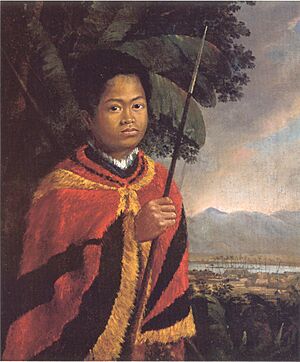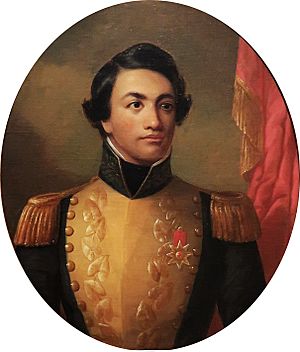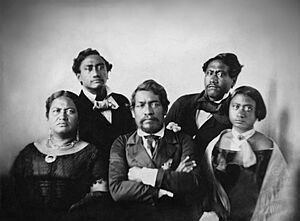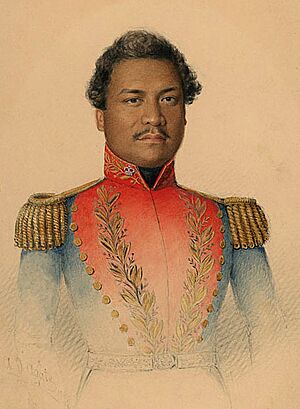Kamehameha III facts for kids
Quick facts for kids Kamehameha III |
|||||
|---|---|---|---|---|---|
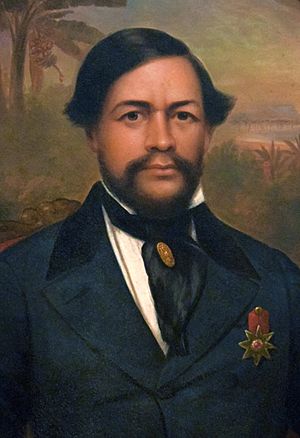
Portrait of Kamehameha III, painted in Boston from a daguerreotype, by an unknown artist
|
|||||
| King of the Hawaiian Islands (more...) | |||||
| Reign | June 6, 1825 – December 15, 1854 | ||||
| Predecessor | Kamehameha II | ||||
| Successor | Kamehameha IV | ||||
| Kuhina Nui | Kaʻahumanu I Kaʻahumanu II Kaʻahumanu III Keoni Ana |
||||
| Born | March 17, 1814 Keauhou Bay at North Kona, Hawaiʻi island |
||||
| Died | December 15, 1854 (aged 40) Hoihoikeʻea, Honolulu, Oʻahu |
||||
| Burial | January 10, 1855 Mauna ʻAla Royal Mausoleum |
||||
| Spouse | Kalama | ||||
| Issue | Keaweaweʻulaokalani I Keaweaweʻulaokalani II Kīwalaʻō (illegitimate) Albert Kūnuiākea (illegitimate) Kamehameha IV (hānai) Kaʻiminaʻauao (hānai) |
||||
|
|||||
| House | Kamehameha | ||||
| Father | Kamehameha I | ||||
| Mother | Keōpūolani | ||||
| Signature | |||||
Kamehameha III (born Kauikeaouli) was the third king of the Kingdom of Hawaii. He ruled from 1825 to 1854. His full Hawaiian name was Keaweaweʻula Kīwalaʻō Kauikeaouli Kaleiopapa. When he became king, his name was lengthened to Keaweaweʻula Kīwalaʻō Kauikeaouli Kaleiopapa Kalani Waiakua Kalanikau Iokikilo Kīwalaʻō i ke kapu Kamehameha.
During his time as king, Hawaii changed from a country ruled by one person (an absolute monarchy) to a country with a set of laws (a constitutional monarchy). This happened when he signed the 1840 Constitution and the 1852 Constitution. He was the longest-reigning monarch in Hawaii's history, ruling for over 29 years. For some of this time, he was guided by a regent, first Queen Kaʻahumanu and then Kaʻahumanu II.
Kamehameha III wanted to balance new Western ideas with Hawaii's old traditions. He worked to keep his nation strong and independent while also modernizing it.
Contents
Early Life of Kauikeaouli
Kauikeaouli was born on March 17, 1814, at Keauhou Bay on Hawaiʻi island. He was the second son of King Kamehameha I and his important wife, Queen Keōpūolani. His birth was special because he was thought to be stillborn, but a prophet named Kapihe said he would live.
The baby was cleaned, prayed over, and sprinkled with water until he started to breathe and cry. The rock where this happened is now a monument at Keauhou Bay. Kauikeaouli was then raised by Chief Kaikioʻewa.
As a young ruler, Kauikeaouli faced challenges. He felt pulled between the strict Christian rules brought by his stepmother, Kaʻahumanu, and his desire to honor old Hawaiian traditions.
Kamehameha III's Reign
When Kauikeaouli became king in 1825, Hawaii's native population was much smaller than it had been. During his reign, the population continued to decrease due to sicknesses.
Marriage and Family Life
In old Hawaii, royal families often married close relatives to keep their bloodlines pure. Kamehameha III had wanted to marry his sister, Nāhiʻenaʻena, but Christian missionaries were against it.
He later chose to marry Kalama Hakaleleponi Kapakuhaili. They married on February 14, 1837, in a Christian ceremony. Kamehameha III and Kalama had two sons, but both died as babies.
He also had two sons, Kīwalaʻō and Albert Kūnuiākea, with another woman named Jane Lahilahi. Kīwalaʻō died young, but Albert Kūnuiākea lived to adulthood and was later adopted by Kamehameha III and Queen Kalama.
Changes in Government
Kamehameha III played a key role in creating Hawaii's first written laws. In 1838, he asked William Richards, a former missionary, to become his political advisor. Richards taught the king and his advisors about Western laws and economics.
Their first important step was a declaration of human rights in 1839. This declaration protected the rights of the Hawaiian people.
New Laws and Constitutions
In 1839, Roman Catholicism was made legal in Hawaii. The first set of laws was also created. Kamehameha III then introduced the Constitution of 1840, which was Hawaii's first constitution. This document set up the government's different parts, like the courts and the executive branch.
A new system for land ownership was also started in 1848, called the Mahele. The 1839 declaration, the 1840 constitution, and other laws were put together in a book called the Kumu Kānāwai, or "foundation of law." These laws were based on Hawaiian traditions, earlier laws, and Christian principles.
The capital of Hawaii was moved from Lahaina to Honolulu during this time.
Protecting Hawaiian Independence
In February 1843, a British captain named Lord George Paulet forced Kamehameha III to give up the Hawaiian kingdom to the British. However, Kamehameha III quickly sent word to London about the captain's actions. Less than five months later, a British admiral named Richard Thomas reversed Paulet's actions, and Hawaii's independence was restored on July 31.
After this event, the king said a famous phrase that became Hawaii's motto: Ua Mau ke Ea o ka ʻĀina i ka Pono — "The life of the land is perpetuated in righteousness." July 31 became a national holiday called Lā Hoʻihoʻi Ea, or Sovereignty Restoration Day. Later that year, on November 28, Britain and France officially recognized Hawaii's independence, which also became a holiday called Lā Kūʻokoʻa.
Government Changes and Land Reform
Throughout the 1840s, a formal legislature of the Hawaiian Kingdom and a cabinet were created. The chiefs became the House of Nobles, and seven elected representatives formed the start of a democratic government.
Kamehameha III also oversaw changes to the court system and land ownership. This led to the Great Mahele of 1848, which divided land among the government, the king, nobles, and commoners. For the first time, foreigners were allowed to own land in Hawaii.
The Constitution of 1852 continued to make the government more open. The court system was made simpler, and voting rules were made clearer.
Later Years and Challenges
The California Gold Rush brought more trade to Hawaii, but also new challenges. Diseases like smallpox arrived, causing many deaths among the native Hawaiians who had no immunity.
There were also rumors of people trying to take over Hawaii. To protect the kingdom, some people suggested that Hawaii join the United States. King Kamehameha III and his advisors said that annexation would only be acceptable if Hawaii became a U.S. state.
In 1852, Kamehameha III sent missionaries from Hawaii to Micronesia. He gave them a letter for the rulers of those islands. The letter encouraged them to accept Christianity and "throw away your idols, take the Lord Jehovah for your God, worship and love Him and He will bless and save you."
On May 16, 1854, King Kamehameha III declared that the Hawaiian Kingdom would remain neutral in the Crimean War in Europe.
Death and Funeral
Kamehameha III died suddenly on December 15, 1854, after a short illness.
His nephew and adopted son, Alexander Liholiho, became the next king, known as King Kamehameha IV.
In 1865, Kamehameha III was reburied in the Royal Mausoleum of Hawaii, also known as Mauna ʻAla.
Legacy and Remembrance
Kamehameha III's birthplace at Keauhou Bay can be reached by Kamehameha III Road.
On July 31, 2018, a 12-foot bronze statue of Kamehameha III was unveiled at Thomas Square. This ceremony honored the 175th anniversary of Hawaii's sovereignty being restored in 1843. The statue was created by artist Thomas Jay Warren.
Family tree
|
||||||||||||||||||||||||||||||||||||||||||||||||||||||||||||||||||||||||||||||||||||||||||||||||||||||||||||||||||||||||||||||||||||||||||||||||||||||||||||||||||||||||||||||||||||||||||||||||||||||||||||||||||||||||||||||||||||||||||||||||||||||||||||||||||||||||||||||||||||||||||||||||||||||||||||||||||||||||||||||||||||||||||||||||||||||||||||||||||||||||||||||||||||||||||||||||||||||||||||||||||||||||||||||||||||||||||||||||||||||||||||||||||||||||||||||||||||||||||||||||||||||||||||||||||||||||||||||||||||||||||||||||||||||||||||||||||||||||||||||||||||||||||||||||||||||||||||||||||||||||||||||||||||||||||||||||||||||||||||||||||||||||||||||||||||||||||||||||||||||||||||||||||||||||||||||||||||||||||||||||||||||||||||||||||||||||||||||||||||||||||||||||||||||||||||||||||||||||||||||||||||||||||||||||||||||||||||||||||||||||||||||||||||||||||||||||||||||||||||||||||||||
| Notes: | ||||||||||||||||||||||||||||||||||||||||||||||||||||||||||||||||||||||||||||||||||||||||||||||||||||||||||||||||||||||||||||||||||||||||||||||||||||||||||||||||||||||||||||||||||||||||||||||||||||||||||||||||||||||||||||||||||||||||||||||||||||||||||||||||||||||||||||||||||||||||||||||||||||||||||||||||||||||||||||||||||||||||||||||||||||||||||||||||||||||||||||||||||||||||||||||||||||||||||||||||||||||||||||||||||||||||||||||||||||||||||||||||||||||||||||||||||||||||||||||||||||||||||||||||||||||||||||||||||||||||||||||||||||||||||||||||||||||||||||||||||||||||||||||||||||||||||||||||||||||||||||||||||||||||||||||||||||||||||||||||||||||||||||||||||||||||||||||||||||||||||||||||||||||||||||||||||||||||||||||||||||||||||||||||||||||||||||||||||||||||||||||||||||||||||||||||||||||||||||||||||||||||||||||||||||||||||||||||||||||||||||||||||||||||||||||||||||||||||||||||||||||
See also
 In Spanish: Kamehameha III para niños
In Spanish: Kamehameha III para niños


